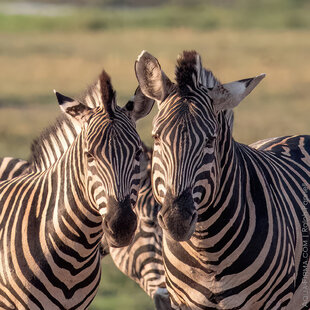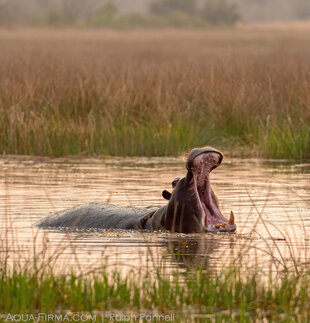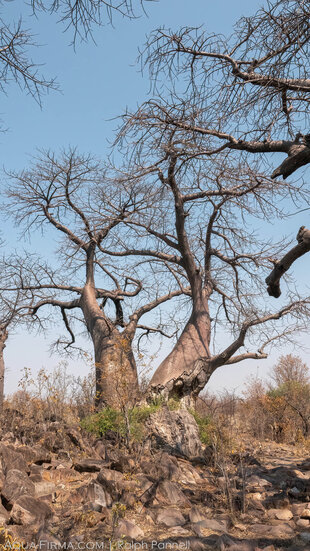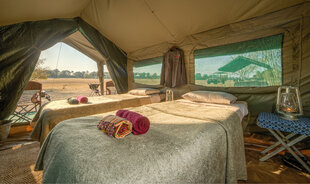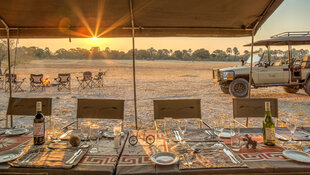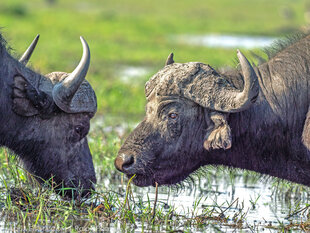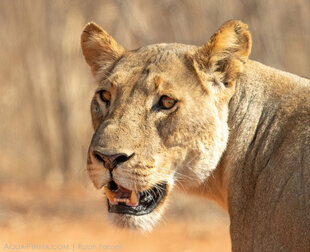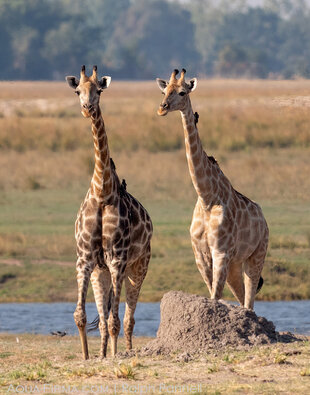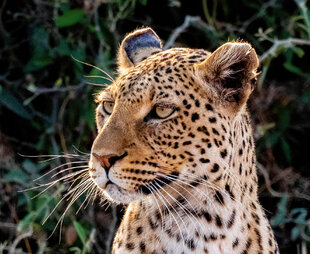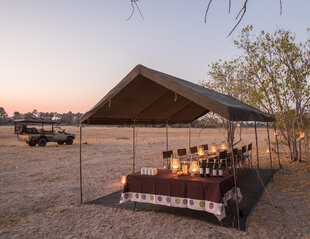Northern Botswana has some of Africa's best preserved wilderness areas. From herbivores to carnivores, these small group & private safaris pass through areas which provide some of the Continent's best opportunities to watch them in action: from big cats and huge herds of elephants & buffalo; to animals much harder to see elsewhere such as African wild dogs. Alongside the wildlife, the diversity of habitat cannot be ignored as you explore everything from marshes of the Okavango Delta, to bushlands and water holes of Chobe National Park.
These small-group premium mobile tented safaris begin with a river-based safari along the Chobe River, before taking you deep into its interior at an area called Savuti (sometimes spelled Savute). From here you will head into the legendary Okavango River Delta, staying at the Mababe private concession and Moremi National Park.
Camping also sets you right inside the heart of Botswana - an unforgettable adventure, but still with good food, a comfortable raised bed, shower, seated toilet, excellent guiding and camararderie of a maximum 7 travellers. This mobile safari is one of our superior tented camp experiences, with larger tents and a tad more comfort than our deluxe options.
Chobe National Park
Your first safari stop is Chobe National Park - an 11,700 km2 area designated as a national park in 1967. This area holds some of Africa's greatest concentrations of wildlife. One third of African elephants survive in Botswana (around 120,000), with the largest contingent of these inhabiting the Chobe region. The river area is a wonderful first area to experience Botswana - both for wildlife and for some of Chobe's 450 different species of bird.
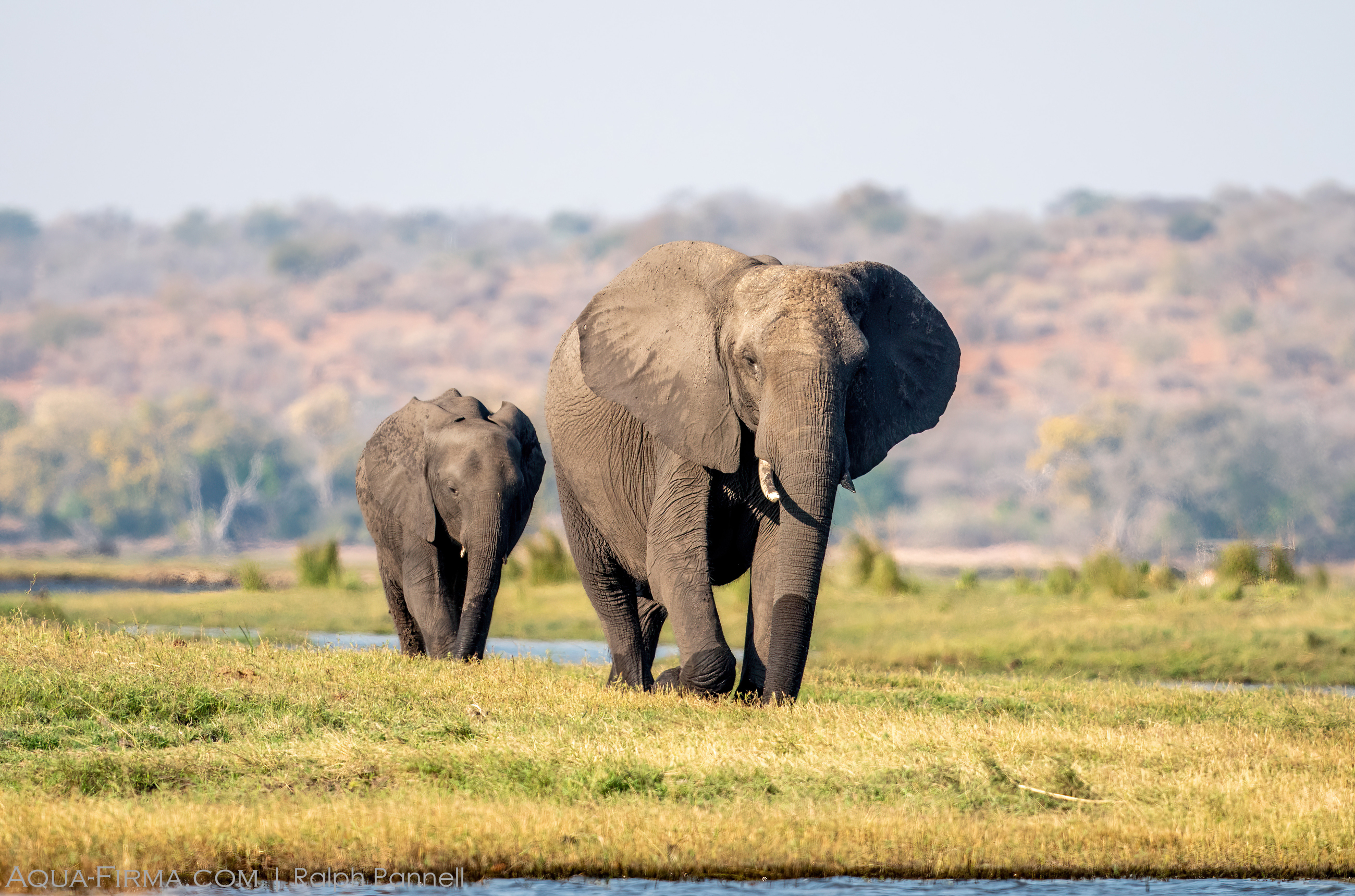
The remote Savuti area provides access to seasonally drier bush, complimented by attractive outcrops of volcanic rock. This unique landscape, with its strategically placed water holes, is a year-round haven on Botswana's vast expanse of Kalahari sands. You can hope for an excellent range of landscape and wildlife photo opportunities before you move on to the Okavango Delta.
Mababe Private Concession
For the next three nights of this safari, you will be in an areas calle Mababe: a 124,000 acre community owned concession at the eastern end of the Okavango Delta, just to the south of Chobe National Park. The Khwai River runs through the reserve, providing year-round water and habitat to thirsty mammals. The chances to see wildlife are excellent, with a maximum of 19 other safari vehicles scattered across this huge wildlife haven.
In addition to daytime game drives, you will also be taken on a nighttime game drive, in search of wildlife you are most unlikely to see by day. Night drives are not something we can do in national park and game park areas.
Moremi
Moremi - a 4,871 km2 Game Reserve which occupies about one third of the Okavango Delta - is your last stop on this wilderness journey. This area is at the southeastern extreme of the Okavango Delta, with the Khwai River providing permanent water and huge plains either side, drying and flooding according to the season. Game is again plentiful here, with rare possibilities of wild dogs and cheetah, as well as excellent chances to see big cats, hundreds of buffalo and excellent birdlife.
& Beyond
If you have time, we can tailor further exploration of Botswana, before or after this mobile safari. This could include lodge-based experiences in:
- Victoria Falls
- the Panhandle of the Okavango Delta
- Central Kalahari Game Reserve
- Makagadikgadi Salt Pans
- Hwange Game Reserve of Zimbabwe
- South Africa, from its winelands of Stellenbosch to private wildlife concessions adjoining the Kruger National Park
Speak to one of our Southern Africa specialists to consider your options.
Itinerary
Okavango & Chobe Mobile Tented Safaris: North to South Itinerary
Starts Kasane & Ends Maun
Day 1 - Kasane & the Chobe River
Arrive Kasane airport where you will be met and transferred privately to the Old House family-owned guest lodge, overlooking the Chobe River (b&b basis).
Day 2 - Chobe River to Savuti
After breakfast and checking out of your hotel, you will be picked up and transferred to a café beside a river jetty. Here you will meet your guide, driver and other members of your safari. Your baggage will be loaded into your safari vehicle, whilst you can take a small pack and camera gear onto a flat-bottomed motor boat which will take you out onto the Chobe River.
Your boat-based safari will take you around a islands which lie between Botswana and Namibia. These are usually excellent for seeing wading birds, Nile crocodiles, some hippos perhaps and usually elephants - sometimes herds numbering in excess of 100. If you are lucky, you might see these crossing the river between islands and the mainland. Where it's deep, the youngest will use their trunks as snorkels.
Back on dry land, your vehicle and guide will then be ready and waiting to drive you through Chobe National Park, all the way to Savuti in Central Chobe. The journey will give you a great opportunity to absorb the vastness of Botswana's bush.
Throughout your safari, you will be travelling in a custom built vehicle with a maximum capacity of 7 guests, plus your guide and driver. The seats are in a three seats per row configuration. There will be a fridge onboard, with drinks available for all guests to dip into anytime whilst on game drives. The vehicle is fitted with inverters and strip plugs allowing you to charge batteries whilst on safari using the ac changer which comes with your device. If you need to purchase an adapter, Botswana uses M3 3-pin Type M plugs (as used in South Africa).
Today's drive takes you from the Chobe River through the wonderful Zambezi teak woodlands of the Chobe Forest Reserve, across the sand-ridge and into the stunted mopane scrub of the Goha clay basin. You will pass through wild country where wildlife moves uninhibited by fences or man. Roan and sable antelope thrive in the teak woodlands, where the low density of predators and lack of competition for food by other ungulates makes this prime habitat for these large grazers. Leopards occur in these woodlands in low numbers; they are highly secretive and seldom seen. The Goha region has natural waterholes which hold water well into the dry season; and herds of buffalo, Plains Zebras, greater kudu and elephant come down to drink.
The most unusual avian species are to be found in the teak (Baikea plurijuga) woodlands. This broad-leafed woodland, or miombo as it is locally known, provides good pickings for insectivorous birds which favour canopy habitat. Grey Tit-Flycatcher, Ashy Flycatcher, Paradise Flycatcher, Pallid Flycatcher, Scarlet-chested Sunbird, Amethyst Sunbird, Yellow-throated Petronia, Red-headed Weaver and Violet-backed Starling are some of the species which move around in 'bird parties' in the canopy. The Dickenson's Kestrel, Red-necked Falcon, Peregrine Falcon and Lizard Buzzard are some of the raptors to keep an eye out for, while the diminutive White-faced Owl can often be seen roosting in the road-side vegetation. Flappet Lark, Fawn-coloured Lark, Dusky Lark, Olive-Tree Warbler and Neddicky are species more likely to be enjoyed by the birding enthusiast.
Your accommodation for the next nine nights will be in a mobile tented camp, which will be set up in different locations over your safari.
The tents are 4 x 3m Sahara style tents with high roof with a 2 x 3m en-suite bathroom and a 2 x 3m covered area in front of the tent. They are fitted with solid base camp beds made up with mattresses, sheets, duvets and pillows. The tents have en-suite long drop toilet facilities and a bucket shower at the rear of the tent. Showers can be ordered as hot, cold or warm and the water is heated in a bucket on the fire. Showers may be taken at any time, but your guide team may need to decide to limit water use and showering if availability of water demands. Both hand towels and bath towels are supplied for your convenience, but you should bring your own personal items and toiletries.
Each tent has an oil / paraffin lamp on the veranda and in the bathroom and within the tent itself, a LED rechargeable camp light is supplied along with a side table in the sleeping area and in the bathroom. Although each tent has lighting and there are lamps strategically around the camp for navigation, an essential tool for your safari is a head torch. This lets you read a book at night in your tent, or catch up with your safari journal as you listen to the sounds of the wild outside! It is advisable to purchase a good head torch and have one available per person.
Days 3 – 4 Savuti (Chobe National Park)
The next two days you will have to explore the Central Chobe area, participating in game drives and walks to see rock art painted by bushmen. Unlike the vast majority of the country, Central Chobe is not a flat landscape. Large outcrops of volcanic rock reach up out of the Kalahari sands, towering over the endless savannah. These hills provide habitat for a completely different array of small wildlife, birds and plants. The Savuti Marsh has been the stage for many of the most dramatic wildlife documentaries in Africa. The wide open country, good ungulate populations and particularly strong prides of lion and hyena clans make for dramatic wildlife interaction and excellent viewing opportunities. The now dry Savuti Channel runs through this landscape linking the drysand-veld, the waterholes, the hills and the grassland which was the Savuti Marsh.
Undoubtedly it is the interaction between lion and elephant which is the most interesting aspect of Savuti. The area is inhabited by a huge pride of lions, with numbers fluctuating from 20-30 members. These remarkable lions have learned over the years how to hunt these massive pachyderms, which are supposedly above predation. Launching their attack under darkness and using their numbers, they are able to kill an adolescent and even young adult elephant.
The marsh is prime cheetah country and in the wet season it is not unusual to find African Wild Dogs hunting here.
The surface water that is pumped by the Government here provides a major attraction for birdlife. In the dry season, thousands of dove and sandgrouse come down to drink in the mornings and are under constant surveillance by Yellow-billed Kite, Tawny Eagle and African Hawk-Eagle. Red-crested Korhaan are common in the Kalahari Apple-leaf (Lonchocarpus nelsii) veld. The marsh is the summer home for good numbers of Caspian Plover and Montague's Harrier as well as Chestnut-backed Sparrowlark, Grey-backed Sparrowlark, Northern Black Korhaan, Rufous-naped Lark, African Pipit and Desert Cisticola. Dickenson's Kestrel, Amur Falcon and Red-necked Falcon are found along the perimeter of the marsh.
Day 5 - Savuti to Mababe
Today, you will pack up and leave this parched landscape and head south to the Mababe Private Reserve area. A fascinating day's drive looking at some of the evidence of the Paleo-Lake Makgadikgadi that dried up some ten thousand years ago. The most challenging part of the trip is crossing the Magwikhwe Sand-ridge which formed the shoreline for this massive inland sea. The winding track through this deep sand makes for interesting travel in the early summer! The old lake bed is now the Mababe Depression. The dense clay floor of the depression results in high protein feed for wildlife and the area teams with game after the rains. During the rainy season the depression is impassable due to the "cotton soil" and alternative routes must be used.
You will pass through most of the habitat types which exist in northern Botswana. Elephants may be seen throughout the drive but are more common at the start and end of the drive where permanent surface water can be found.
The Mababe Depression is a birder's paradise. The nutritious grasses that grow on the rich soils, provide excellent seed for an impressive array of estrillids and viduids. Among these are the magnificently coloured Violet-eared Waxbill, Black-cheeked Waxbill, Village Indigobird, Shaft-tailed Whydah and Paradise Whydah.
These in turn provide a good food source for small raptors such as the Little Sparrowhawk, Shikra, Gabar Goshawk, Red-necked Falcon and Lanner Falcon. It is not only the small birds that feed on the grass seeds, but rodents too. There are annual outbreaks of huge numbers of rats and mice. As a result, huge numbers of Secretary Bird, Tawny Eagle, Black-shouldered Kite, Steppe Eagle, Lesser-spotted Eagle, Wahlberg's Eagle and Steppe Buzzard can be found.
Days 6 – 7 Mababe
The next two days you will explore the Mababe area. The Khwai River meanders through the concession giving ample riverside routes to explore. We spend the following two nights camping at an exclusive campsite in the Mababe concession, which has a strict maximum of 20 vehicles at any given time. You will ne exploring the riverbanks, Kalahari shrub to the east, cathedral mopane woodlands to the south, on game drives both during the day and at night. Exploring after dark with spotlights offers you an opportunity to experience some of the nocturnal animals which are rarely encountered during the day.
You may also have the opportunity to explore the surrounding wilderness on foot, to enjoy an up close and personal encounter with Botswana's flora and fauna. It is important to note that night drives and guided walks are not permitted within national parks and reserves. These activities are conducted outside the boundaries of the Moremi Game Reserve, in the Mababe Private Reserve.
You will spend your time between the dry-land habitats of the lead-wood and camel-thorn woodlands and savannahs and the riverside banks of the Khwai River, as well as the "mini-CKGR" habitat in the western parts of the concession (CKGR = Central Kalahari Game Reserve).
The Mababe region boasts excellent populations of both bull elephants and breeding herds. Lion, leopard, serval and African wildcat are common predators of the region, with wild dog and cheetah being less common.
Buffalo use this area seasonally with large herds moving in during the summer rains. Other ungulates include tsessebe, blue wildebeest, giraffe, kudu, sable antelope, roan antelope and impala, and even eland and oryx in the western parts.
Botswana's national bird, the Kori Bustard, is a resident in the lower reaches of the Mababe Depression. The western reaches are prime habitat for the uncommon Rosy-throated Longclaw. The entire length of the river is hunting domain for the Bat-Hawk. Other interesting raptors here are Cuckoo Hawk (rare), Long-crested Eagle and Black Sparrowhawk. More commonly Tawny Eagle, Steppe Eagle, Lesser-spotted Eagle, Martial Eagle, Bateleur and African Hawk-Eagle. The waterways host Africa Rail, African Crake, Greater Painted Snipe, Allen's Gallinule, Lesser Jacana and Lesser Moorhen.
Day 8 - Mababe to Xakanaxa
Today, you will move on from Mababe and drive further south to Xakanaxa. This will be a full day of extended game drive and a picnic lunch along the way.
This morning you head towards and through Khwai, stopping to do a mokoro excursion on the slower and safer back waters of the Khwai River and the Mbudi channel. The day's journey follows this water course, with the track weaving from the riverside and floodplains into the mopane veld and the woodlands before crossing the Khwai River and entering the Moremi Game Reserve.
The western mopane veld is home to mostly breeding herds of elephant, whilst the eastern reaches of Khwai is home to some impressive old bulls. The mature bulls revel in the cool waters of the Khwai River and are far more approachable while drinking and bathing than the breeding herds. The river has an unusually high density of hippo as well as some huge crocodile. Leopard, cheetah, serval and lion are common predators along this route and both Xakanaxa as well as Mababe are included in the home ranges of different packs of wild dog.
General game includes southern giraffe, Burchell's zebra, tsessebe and red lechwe, with roan and sable antelope being less common residents. In the mopane woodlands African Hawk-Eagle, Tawny Eagle, Gabar Goshawk, Little Sparrowhawk, African Harrier Hawk and Shikra are common raptors. Mixed bird parties move through the canopy and include Redheaded Weaver, Stierling's Wren-Warbler, Scarlet-chested Sunbird, Neddicky, Yellow-breasted Apalis, Chin-spot Batis, Diederik Cuckoo to name but a few. The verges of the swamp form breeding grounds for the Rosy-Longclaw, Black Coucal, Long-legged Bustard and the African Crake.
Days 9 – 10 Moremi Game Reserve (Okavango Delta)
The next two days, you will explore the Moremi Game Reserve. Moremi lies on the eastern extremity of the Okavango Delta. Habitats here range from wide-open floodplains, marshes, lagoons, papyrus fringed channels, vast reed-beds of Miscanthus and Phragmites, woodland and savannah. As a result of the extremely variable habitat the diversity of both wildlife and birdlife is excellent.
Every type of mopane habitat is well represented in this drive, from the towering cathedral woodlands Xakanaxa, to the classic climax mopane woodland and in the drier and harsher habitats, extensive stretches of scrub mopane. The San-ta-Wani region has scattered ephemeral water pans with large floodplains and camel-thorn woodlands. 40 km of the drive is in Moremi Game Reserve, with a further 40 km in areas designated for wildlife management where animals roam freely to and from the Game Reserve.
A good day for raptors with African Hawk-Eagle, Gabar Goshawk, Shikra, Little Sparrowhawk, Dark Chanting Goshawk, Tawny Eagle, Lesser Spotted Eagle and Steppe Eagle; all inhabiting the mopane and adjacent woodlands. Other birds common along this route includes most of Botswana's hornbills including Red -billed, Southern Yellow-billed, African Grey, Bradfield's and the Southern Ground Hornbills. A large number of broodparasites may also be seen. Diederick Cuckoo, Levaillant's Cuckoo, Jacobin Cuckoo, Great-spotted Cuckoo, African Cuckoo, Common Cuckoo, Shaft-tailed Whydah, Pin-tailed Whydah, Eastern Paradise Whydah, Greater Honeyguide, and Lesser Honeyguide.
Day 11 - Maun
After breakfast and an early morning game drive, you will be taken to an airstrip for a small-plane charter flight back to Maun, arriving at around 12:30. This small-plane flight can provide an excellent aerial perspective of the fringes of the Okavango Delta.
Okavango & Chobe Mobile Tented Safaris: South to North Itinerary
Starts Maun & Ends Kasane
Day 1 - Maun
Arrive Maun airport, where you will be met and transferred to your hotel for the night (B&B basis)
Day 2 Maun - Moremi
After breakfast this morning, you will be met and directed to your charter flight to the Xakanaxa airstrip in Moremi Game Reserve. Here you will meet the rest of your group, driver and guide who will accompany you on your safari.
From the air, only the larger animals are easily seen. These include large breeding herds of African elephant that live in the mopane scrub. On the open plains large herds of buffalo and lechwe can be seen and in the waterways, pods of hippopotamus are a common sight. Once you land in Xakanaxa and board your land cruiser, the smaller game animals can be found.
Throughout your safari, you will be travelling in a custom-built vehicle with a maximum capacity of 7 guests, plus your guide and driver. The seats are in a three seats per row configuration. There will be a fridge onboard, with drinks available for all guests to dip into anytime whilst on game drives. The vehicle is fitted with inverters and strip plugs allowing you to charge batteries whilst on safari using the ac changer which comes with your device. If you need to purchase an adapter, Botswana uses M3 3-pin Type M plugs (as used in South Africa).
Your first three nights are spent camping in the Xakanaxa region where you will explore the surrounding wilderness on morning and afternoon game drive excursions.
The Xabanaxa area is excellent for birding, with the possibility of species spotted being: African Hawk-Eagle, Gabar Goshawk, Shikra, Little Sparrowhawk, Dark Chanting Goshawk, Tawny Eagle, Lesser Spotted Eagle* and Steppe Eagle* all inhabiting the mopane and adjacent woodlands.
Other birds that are common in this region and essential to look out for includes: most of Botswana’s hornbills including Red-billed, Southern Yellow-billed, African Grey, Bradfield’s and the Southern Ground Hornbills. A large number of brood-parasites may also be seen. Diederick Cuckoo, Levaillant’s Cuckoo, Jacobin Cuckoo, Great-spotted Cuckoo, African Cuckoo, Common Cuckoo, Shaft-tailed Whydah, Pintailed Whydah, Eastern Paradise Whydah, Greater Honeyguide, and Lesser Honeyguide.
Your accommodation for the next nine nights will be in a mobile tented camp, which will be set up in different locations over your safari.
The tents are 4 x 3m Sahara style tents with high roof with a 2 x 3m en-suite bathroom and a 2 x 3m covered area in front of the tent. They are fitted with solid base camp beds made up with mattresses, sheets, duvets and pillows. The tents have en-suite long drop toilet facilities and a bucket shower at the rear of the tent. Showers can be ordered as hot, cold or warm and the water is heated in a bucket on the fire. Showers may be taken at any time, but your guide team may need to decide to limit water use and showering if availability of water demands. Both hand towels and bath towels are supplied for your convenience, but you should bring your own personal items and toiletries.
Each tent has an oil / paraffin lamp on the veranda and in the bathroom and within the tent itself, a LED rechargeable camp light is supplied along with a side table in the sleeping area and in the bathroom. Although each tent has lighting and there are lamps strategically around the camp for navigation, an essential tool for your safari is a head torch. This lets you read a book at night in your tent, or catch up with your safari journal as you listen to the sounds of the wild outside! It is advisable to purchase a good head torch and have one available per person.
Days 3 - 4 Moremi
Moremi lies on the eastern extremity of the Okavango Delta. Habitats here range from wide-open floodplains, marshes, lagoons, papyrus fringed channels, vast stands of Miscanthus and Phragmites, woodland and savannah. As a result of the extremely variable habitat the diversity of both wildlife and birdlife is excellent.
You will explore the Xakanaxa region, which is home to a resident herd of several hundred buffalo whose range covers the territories of at least 4 prides of lion which may often be seen flanking the ever-moving herd. Breeding herds of elephant move between their browsing areas in the mopane forests and the fresh water of the Okavango. Red lechwe are one of the more unusual antelope species and commonly found here. It is also amongst the best game reserves in Africa for viewing the endangered African wild dog.
Fore keen birders, the swampy areas of Xakanaxa are home to African Rail, Coppery-tailed Coucal, Black Coucal, Red-chested Flufftail, African Crake, Black Crake, Chirping Cisticola, Luapula Cisticola, Purple Swamphen, Allen’s Gallinule to name but a few. The open waters also attract African Skimmer, Saddle-billed Stork, Yellow-billed Stork, Intermediate Egret, Goliath Heron, African Fish Eagle as well as the globally threatened Slaty Egret and Wattled Crane.
Day 5 Moremi - Mababe
Following an early morning breakfast today, you take a slow drive through Moremi Game Reserve north-east towards the Khwai and Mababe Areas. On this moving day you may have the opportunity to do a mokoro excursion in the calmer back-waters of the Khwai and Mbudi channels as opposed to doing the mokoro in the quicker moving section of the Khwai River that runs through Mababe.
The Manuchira Channel is known as the Khwai River at its eastern most extremity. The day’s journey follows this water course, with the track weaving from the riverside and floodplains into the mopane veld and the woodlands that to the Mababe Private Reserve where you camp on the banks of the Khwai River before it flows out and into the Mababe Depression. You will pass the magnificent Dombo Hippo Pools in the morning stopping to enjoy the scenery and the antics of the resident hippo and shall game drive through Khwai until you reach Mababe.
The south-east mopane veld is home to mostly breeding herds of elephant whilst the more northern reaches of Mababe is home to some impressive old bulls. The mature bulls revel in the cool waters of the Khwai River and are far more approachable while drinking and bathing than the breeding herds. The river has an unusually high density of hippo as well as some huge crocodile. Leopard, cheetah, serval and lion are common predators along this route and both Xakanaxa as well as Mababe are included in the home ranges of different packs of wild dog.
General game includes southern giraffe, Burchell’s zebra, tsessebe and red lechwe with roan and sable antelope being less common residents. In the mopane woodlands African Hawk-Eagle, Tawny Eagle, Gabar Goshawk, Little Sparrowhawk, African Harrier Hawk and Shikra are common raptors. Mixed bird parties move through the canopy and include Red-headed Weaver, Stierling’s Wren-Warbler, Scarlet-chested Sunbird, Neddicky, Yellow-breasted Apalis, Chin-spot Batis, Diederik Cuckoo. The verges of the swamp form breeding grounds for the Rosy-Longclaw, Black Coucal, Long-legged Bustard and the African Crake.
Days 6 - 7 Mababe
The Khwai River meanders through the concession giving ample riverside routes to explore. You will spend the following two nights camping at an exclusive campsite in the Mababe concession that has a strict max of 20 vehicles for the whole concession at any given time. You will spend your time exploring the river banks, Kalahari shrub to the east and cathedral mopane to the south on game drives both during the day and at night. Exploring after dark with spotlights offers you an opportunity to experience some of the nocturnal animals that are rarely encountered during the day.
You may also have the opportunity to explore the surrounding wilderness on foot, to enjoy an up close and personal encounter with Botswana’s flora and fauna. It is important to note that night drives and guided walks are not permitted within national parks and reserves. These activities are conducted outside the boundaries of the Moremi Game Reserve, in the Mababe Private Reserve.
You will spend your time between the dry-land habitats of the lead-wood and camel-thorn woodlands and savannahs and the riverside and marshy back-waters of the Khwai as well as the “mini-CKGR” habitat in the western parts of the concession (CKGR = Central Kalahari Game Reserve).
The Khwai region boasts excellent populations of both bull elephant as well as breeding herds. Lion, leopard, serval and African wildcat are common predators of the region with wild dog and cheetah being less common.
Buffalo use this area seasonally with large herds moving in during the summer rains. The swampy areas in the west are home to red lechwe. Other ungulates include tsesebe, blue wildebeest, giraffe, kudu, sable antelope, roan antelope and impala.
Truly one of Botswana birding Mecca’s. The western reaches are prime habitat for the uncommon Rosythroated Longclaw. The entire length of the river is hunting domain for the Bat-Hawk. Other interesting raptors here are Cuckoo Hawk (rare), Long-crested Eagle and Black Sparrowhawk. More commonly Tawny Eagle, Steppe Eagle, Lesser-spotted Eagle, Martial Eagle, Bateleur and African Hawk-Eagle. The waterways host Africa Rail, African Crake, Greater Painted Snipe, Allen’s Gallinule, Lesser Jacana and Lesser Moorhen.
Day 8 Mababe - Central Chobe
Today, after breakfast, you will head further north en-route to Central Chobe region, exploring the desert-like landscape on game drives.
You will spend a fascinating days drive looking at some of the evidence of the Paleo-Lake Makgadikgadi that dried up some ten thousand years ago. The most challenging part of the trip is crossing the Magwikwe Sand-ridge that formed the shoreline for this massive inland sea. The winding track through this deep sand makes for interesting travel in the early summer! The old lake bed is now the Mababe Depression. The dense clay floor of the depression result in high protein feed for wildlife and the area teams with game after the rains. During the rainy season the depression is impassable due to the “cotton soil” and alternative routes must be used.
The range of habitat that is covered encompasses most of the habitat types of northern Botswana. You will pass through excellent lion country and some of the best cheetah country that your safari will cover. Elephant occur throughout the drive but are more common at the start and end of the drive where permanent surface water can be found.
The Mababe Depression is a birder’s paradise. The nutritious grasses that grow on the rich soils provide excellent seed for an impressive array of estrillids and viduids. Among these are the magnificently coloured Violet-eared Waxbill, Black-cheeked Waxbill, Village Indigobird, Shaft-tailed Whydah and Paradise Whydah. These in turn provide a good food source for small raptors such as the Little Sparrowhawk, Shikra, Gabar Goshawk, Red-necked Falcon and Lanner Falcon. It is not only the small birds that feed on the grass seeds, but rodents too. There are annual outbreaks of huge numbers of rats and mice. As a result, large numbers of Secretary Bird, Tawny Eagle, Black-shouldered Kite, Steppe Eagle, Lesser-spotted Eagle, Wahlberg’s Eagle and Steppe Buzzard can be found hunting here.
Days 9 - 10 Central Chobe
Unlike the vast majority of the country, Central Chobe is not a totally flat landscape. Large outcrops of volcanic rock reach up out of the Kalahari sands, towering over the endless savannah. These hills provide habitat for a completely different array of small wildlife, birds and plants. The Savuti Marsh has been the stage for many of the most dramatic wildlife documentaries in Africa. The wide open country, good ungulate populations and particularly strong prides of lion and hyaena clans make for dramatic wildlife interaction and excellent viewing opportunities. The now dry Savuti Channel runs through this landscape linking the dry sand-veld, the waterholes, the hills and the grassland that was the Savuti Marsh.
Undoubtedly it is the interaction between lion and elephant that is the most interesting aspect of Savuti. The area is inhabited by a huge pride of lions with numbers fluctuating from 20-30 members. These remarkable lions have learned over the years how to hunt these massive pachyderms that are supposedly above predation. Launching their attack under darkness and using their numbers, they manage to kill adolescent and even young adult elephant.
The marsh is prime cheetah country and in the wet season it is not unusual to have the wild dog hunting here in Central Chobe.
The surface water that is pumped by the Government here provides a major attraction for birdlife. In the dry season thousands of dove and sandgrouse come down to drink in the mornings and are under constant surveillance by Yellow-billed Kite, Tawny Eagle and African Hawk-Eagle. Red-crested Korhaan are common in the Kalahari Apple-leaf (Lonchocarpus nelsii) veld. The marsh is the summer home for good numbers of Caspian Plover and Montague’s Harrier as well as Chestnut-backed Sparrowlark, Grey-backed Sparrowlark, Northern Black Korhaan, Rufous-naped Lark, African Pipit and Desert Cisticola. Dickenson’s Kestrel, Amur Falcon and Red-necked Falcon can be found along the perimeter of the marsh.
Day 11 Central Chobe - Chobe River
On the final day of safari, you will leave Central Chobe early to travel along the Chobe River arriving in Kasane where you will stop for a picnic lunch before taking an afternoon boat cruise to end the journey.
Today’s drive takes you through the stunted mopane scrub of the Goha clay basin, across the sand-ridge and through the wonderful Zambezi teak woodlands of the Chobe Forest Reserve and along the Chobe River itself. The Chobe floodplain is tens of kilometers wide and in years of exceptional rains the water stretches as far as the eye can see.
While there are community areas that you pass through that are settled by local tribes, for the vast majority of the day’s drive you pass through wild country where wildlife moves un-inhibited by fences or man. Roan and sable antelope thrive in the teak woodlands where the low density of predators and lack of competition for food by other ungulates makes this prime habitat for these large ungulates. Leopard occur in these woodlands in low numbers but they are highly secretive and seldom seen. The Goha region has natural waterholes that hold water well into the dry season and herds of buffalo, Burchell’s zebra, greater kudu and elephant come down to drink.
The most unusual species are to be found in the teak (Baikea plurijuga) woodlands. This broad-leafed woodland, or miombo as it is locally known, provides good pickings for insectivorous birds that favour canopy habitat. Grey Tit-Flycatcher, Ashy Flycatcher, Paradise Flycatcher, Pallid Flycatcher, Scarlet-chested Sunbird, Amethyst Sunbird, Yellow-throated Petronia, Red-headed Weaver and Violet-backed Starling are only some of the species that move around in the “bird parties” in the canopy. Dickenson’s Kestrel, Red-necked Falcon, Peregrine Falcon and Lizard Buzzard are some of the raptors to keep an eye out for, while the diminutive White-faced Owl can often be seen roosting in the road-side vegetation. Flappet Lark, Fawn-coloured Lark, Dusky Lark, Olive-Tree Warbler and Neddicky are species more likely to be enjoyed by the birding enthusiast.
As your safari comes to an end, you will part ways with your group as you head to your hotel or the airport for your onward travel.
Dates
US $ 4,080
11-day South - North Itinerary (Okavango - Chobe NP )
Starts Maun & Ends Kasane
US $ 4,080
11-day South - North Itinerary (Okavango - Chobe NP )
Starts Maun & Ends Kasane
from US$ 4,080
11-day North to South Itinerary (Chobe NP - Okavango)
Starts Kasane & Ends Maun
US $ 4,080
11-day South - North Itinerary (Okavango - Chobe NP )
Starts Maun & Ends Kasane
US $ 4,080
11-day South - North Itinerary (Okavango - Chobe NP )
Starts Maun & Ends Kasane
US$ 4,080
11-day North to South Itinerary (Chobe NP - Okavango)
Starts Kasane & Ends Maun
US$ 4,080
11-day North to South Itinerary (Chobe NP - Okavango)
Starts Kasane & Ends Maun
US $ 4,080
11-day South - North Itinerary (Okavango - Chobe NP )
Starts Maun & Ends Kasane
US $ 4,080
11-day South - North Itinerary (Okavango - Chobe NP )
Starts Maun & Ends Kasane
US $ 4,080
11-day South - North Itinerary (Okavango - Chobe NP )
Starts Maun & Ends Kasane
US $ 4,080
11-day South - North Itinerary (Okavango - Chobe NP )
Starts Maun & Ends Kasane
US $ 4,080
11-day South - North Itinerary (Okavango - Chobe NP )
Starts Maun & Ends Kasane
US $ 5,760
11-day South - North Itinerary (Okavango - Chobe NP )
Starts Maun & Ends Kasane
US $ 5,760
11-day South - North Itinerary (Okavango - Chobe NP )
Starts Maun & Ends Kasane
US$ 5,760
11-day North to South Itinerary (Chobe NP - Okavango)
Starts Kasane & Ends Maun
US $ 5,760
11-day South - North Itinerary (Okavango - Chobe NP )
Starts Maun & Ends Kasane
US$ 5,760
11-day North to South Itinerary (Chobe NP - Okavango)
Starts Kasane & Ends Maun
US $ 5,760
11-day South - North Itinerary (Okavango - Chobe NP )
Starts Maun & Ends Kasane
US $ 5,760
11-day South - North Itinerary (Okavango - Chobe NP )
Starts Maun & Ends Kasane
US $ 5,760
11-day South - North Itinerary (Okavango - Chobe NP )
Starts Maun & Ends Kasane
US $ 5,760
11-day South - North Itinerary (Okavango - Chobe NP )
Starts Maun & Ends Kasane
US $ 5,760
11-day South - North Itinerary (Okavango - Chobe NP )
Starts Maun & Ends Kasane
US $ 5,760
11-day South - North Itinerary (Okavango - Chobe NP )
Starts Maun & Ends Kasane
US $ 6,490
11-day South - North Itinerary (Okavango - Chobe NP )
Starts Maun & Ends Kasane
US $ 6,490
11-day South - North Itinerary (Okavango - Chobe NP )
Starts Maun & Ends Kasane
US $ 6,490
11-day South - North Itinerary (Okavango - Chobe NP )
Starts Maun & Ends Kasane
US $ 6,490
11-day South - North Itinerary (Okavango - Chobe NP )
Starts Maun & Ends Kasane
US $ 6,490
11-day South - North Itinerary (Okavango - Chobe NP )
Starts Maun & Ends Kasane
US $ 6,490
11-day South - North Itinerary (Okavango - Chobe NP )
Starts Maun & Ends Kasane
US $ 6,490
11-day South - North Itinerary (Okavango - Chobe NP )
Starts Maun & Ends Kasane
US $ 6,490
11-day South - North Itinerary (Okavango - Chobe NP )
Starts Maun & Ends Kasane
US $ 6,490
11-day South - North Itinerary (Okavango - Chobe NP )
Starts Maun & Ends Kasane
US $ 6,490
11-day South - North Itinerary (Okavango - Chobe NP )
Starts Maun & Ends Kasane
US $ 6,490
11-day South - North Itinerary (Okavango - Chobe NP )
Starts Maun & Ends Kasane
US$ 6,490
11-day North to South Itinerary (Chobe NP - Okavango)
Starts Kasane & Ends Maun
6,490
11-day North to South Itinerary (Chobe NP - Okavango)
Starts Kasane & Ends Maun
US $ 6,490
11-day South - North Itinerary (Okavango - Chobe NP )
Starts Maun & Ends Kasane
US $ 6,490
11-day South - North Itinerary (Okavango - Chobe NP )
Starts Maun & Ends Kasane
US$ 6,490
11-day North to South Itinerary (Chobe NP - Okavango)
Starts Kasane & Ends Maun
US $ 6,490
11-day South - North Itinerary (Okavango - Chobe NP )
Starts Maun & Ends Kasane
US $ 6,490
11-day South - North Itinerary (Okavango - Chobe NP )
Starts Maun & Ends Kasane
US$ 6,490
11-day North to South Itinerary (Chobe NP - Okavango)
Starts Kasane & Ends Maun
US $ 6,490
11-day South - North Itinerary (Okavango - Chobe NP )
Starts Maun & Ends Kasane
from US$ 6,490
11-day North to South Itinerary (Chobe NP - Okavango)
Starts Kasane & Ends Maun
US $ 6,490
11-day South - North Itinerary (Okavango - Chobe NP )
Starts Maun & Ends Kasane
US $ 6,490
11-day South - North Itinerary (Okavango - Chobe NP )
Starts Maun & Ends Kasane
US $ 6,490
11-day South - North Itinerary (Okavango - Chobe NP )
Starts Maun & Ends Kasane
US $ 6,490
11-day South - North Itinerary (Okavango - Chobe NP )
Starts Maun & Ends Kasane
US$ 6,490
11-day North to South Itinerary (Chobe NP - Okavango)
Starts Kasane & Ends Maun
US $ 6,490
11-day South - North Itinerary (Okavango - Chobe NP )
Starts Maun & Ends Kasane
from 6,490
11-day North to South Itinerary (Chobe NP - Okavango)
Starts Kasane & Ends Maun
US $ 6,490
11-day South - North Itinerary (Okavango - Chobe NP )
Starts Maun & Ends Kasane
US $ 6,490
11-day South - North Itinerary (Okavango - Chobe NP )
Starts Maun & Ends Kasane
US $ 6,490
11-day South - North Itinerary (Okavango - Chobe NP )
Starts Maun & Ends Kasane
US $ 6,490
11-day South - North Itinerary (Okavango - Chobe NP )
Starts Maun & Ends Kasane
from US$ 5,760
11-day North to South Itinerary (Chobe NP - Okavango)
Starts Kasane & Ends Maun
US $ 5,760
11-day South - North Itinerary (Okavango - Chobe NP )
Starts Maun & Ends Kasane
US$ 5,760
11-day North to South Itinerary (Chobe NP - Okavango)
Starts Kasane & Ends Maun
US$ 5,760
11-day North to South Itinerary (Chobe NP - Okavango)
Starts Kasane & Ends Maun
US $ 5,760
11-day South - North Itinerary (Okavango - Chobe NP )
Starts Maun & Ends Kasane
US$ 5,760
11-day North to South Itinerary (Chobe NP - Okavango)
Starts Kasane & Ends Maun
US $ 5,760
11-day South - North Itinerary (Okavango - Chobe NP )
Starts Maun & Ends Kasane
from US$ 4,080
11-day North to South Itinerary (Chobe NP - Okavango)
Starts Kasane & Ends Maun
US $ 4,080
11-day South - North Itinerary (Okavango - Chobe NP )
Starts Maun & Ends Kasane
US $ 4,080
11-day South - North Itinerary (Okavango - Chobe NP )
Starts Maun & Ends Kasane
from US$ 4,080
11-day North to South Itinerary (Chobe NP - Okavango)
Starts Kasane & Ends Maun
US $ 4,080
11-day South - North Itinerary (Okavango - Chobe NP )
Starts Maun & Ends Kasane
US $ 4,080
11-day South - North Itinerary (Okavango - Chobe NP )
Starts Maun & Ends Kasane
11-day North to South Itinerary (Chobe NP - Okavango)
Starts Kasane & Ends Maun
US $ 4,080
11-day South - North Itinerary (Okavango - Chobe NP )
Starts Maun & Ends Kasane
US $ 4,080
11-day South - North Itinerary (Okavango - Chobe NP )
Starts Maun & Ends Kasane
US $ 4,080
11-day South - North Itinerary (Okavango - Chobe NP )
Starts Maun & Ends Kasane
US $ 4,080
11-day South - North Itinerary (Okavango - Chobe NP )
Starts Maun & Ends Kasane
US $ 4,080
11-day South - North Itinerary (Okavango - Chobe NP )
Starts Maun & Ends Kasane
US $ 4,080
11-day South - North Itinerary (Okavango - Chobe NP )
Starts Maun & Ends Kasane
US $ 5,760
11-day South - North Itinerary (Okavango - Chobe NP )
Starts Maun & Ends Kasane
US $ 5,760
11-day South - North Itinerary (Okavango - Chobe NP )
Starts Maun & Ends Kasane
US $ 5,760
11-day South - North Itinerary (Okavango - Chobe NP )
Starts Maun & Ends Kasane
US $ 5,760
11-day South - North Itinerary (Okavango - Chobe NP )
Starts Maun & Ends Kasane
US $ 5,760
11-day South - North Itinerary (Okavango - Chobe NP )
Starts Maun & Ends Kasane
US $ 5,760
11-day South - North Itinerary (Okavango - Chobe NP )
Starts Maun & Ends Kasane
US $ 5,760
11-day South - North Itinerary (Okavango - Chobe NP )
Starts Maun & Ends Kasane
US $ 5,760
11-day South - North Itinerary (Okavango - Chobe NP )
Starts Maun & Ends Kasane
US $ 6,490
11-day South - North Itinerary (Okavango - Chobe NP )
Starts Maun & Ends Kasane
US $ 6,490
11-day South - North Itinerary (Okavango - Chobe NP )
Starts Maun & Ends Kasane
US $ 6,490
11-day South - North Itinerary (Okavango - Chobe NP )
Starts Maun & Ends Kasane
US $ 6,490
11-day South - North Itinerary (Okavango - Chobe NP )
Starts Maun & Ends Kasane
US $ 6,490
11-day South - North Itinerary (Okavango - Chobe NP )
Starts Maun & Ends Kasane
US $ 6,490
11-day South - North Itinerary (Okavango - Chobe NP )
Starts Maun & Ends Kasane
US $ 6,490
11-day South - North Itinerary (Okavango - Chobe NP )
Starts Maun & Ends Kasane
US $ 6,490
11-day South - North Itinerary (Okavango - Chobe NP )
Starts Maun & Ends Kasane
US $ 6,490
11-day South - North Itinerary (Okavango - Chobe NP )
Starts Maun & Ends Kasane
US $ 6,490
11-day South - North Itinerary (Okavango - Chobe NP )
Starts Maun & Ends Kasane
US $ 6,490
11-day South - North Itinerary (Okavango - Chobe NP )
Starts Maun & Ends Kasane
US $ 6,490
11-day South - North Itinerary (Okavango - Chobe NP )
Starts Maun & Ends Kasane
US $ 6,490
11-day South - North Itinerary (Okavango - Chobe NP )
Starts Maun & Ends Kasane
US $ 6,490
11-day South - North Itinerary (Okavango - Chobe NP )
Starts Maun & Ends Kasane
US $ 6,490
11-day South - North Itinerary (Okavango - Chobe NP )
Starts Maun & Ends Kasane
US $ 6,490
11-day South - North Itinerary (Okavango - Chobe NP )
Starts Maun & Ends Kasane
US $ 6,490
11-day South - North Itinerary (Okavango - Chobe NP )
Starts Maun & Ends Kasane
US $ 6,490
11-day South - North Itinerary (Okavango - Chobe NP )
Starts Maun & Ends Kasane
US $ 6,490
11-day South - North Itinerary (Okavango - Chobe NP )
Starts Maun & Ends Kasane
US $ 6,490
11-day South - North Itinerary (Okavango - Chobe NP )
Starts Maun & Ends Kasane
US $ 6,490
11-day South - North Itinerary (Okavango - Chobe NP )
Starts Maun & Ends Kasane
US $ 6,490
11-day South - North Itinerary (Okavango - Chobe NP )
Starts Maun & Ends Kasane
US $ 6,490
11-day South - North Itinerary (Okavango - Chobe NP )
Starts Maun & Ends Kasane
US $ 6,490
11-day South - North Itinerary (Okavango - Chobe NP )
Starts Maun & Ends Kasane
US $ 5,760
11-day South - North Itinerary (Okavango - Chobe NP )
Starts Maun & Ends Kasane
US $ 5,760
11-day South - North Itinerary (Okavango - Chobe NP )
Starts Maun & Ends Kasane
US $ 5,760
11-day South - North Itinerary (Okavango - Chobe NP )
Starts Maun & Ends Kasane
US $ 4,080
11-day South - North Itinerary (Okavango - Chobe NP )
Starts Maun & Ends Kasane
US $ 4,080
11-day South - North Itinerary (Okavango - Chobe NP )
Starts Maun & Ends Kasane
Price includes
All guiding
All meals on safari
Breakfast in Kasane hotel
All house drinks on safari (local beers, bottled wine, gin, juices ...)
Drinking water
All safari transportation including flight from Moremi to Maun final day
Safari accommodation in a premium mobile safari tent with raised bed & bedding & en suite safari bathroom, closed at the sides and open to the stars
Kasane hotel 1 night
Park fees
Not included
Tips
Personal travel insurance
Flights

